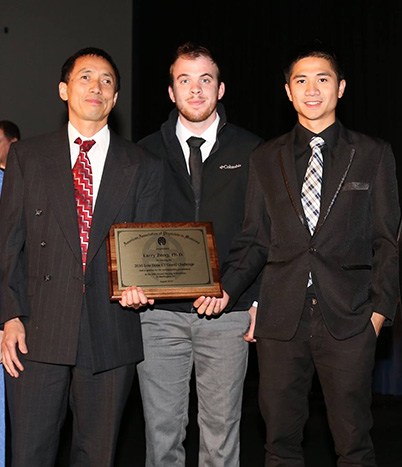WSU Engineering Department Awarded Grant for Medical Imaging Research
OGDEN, Utah — Engineering associate professor Larry Zeng has researched medical imaging for almost 30 years. Now to support his research, the National Institute of Health (NIH) has awarded a three-year grant totaling more than $270,000.
This is the first National Institute of Health grant awarded to Weber State to lead the research. The financial support allows Zeng to expand his research, as well as train students to work with him. Funding allows his students opportunities to solve real-world problems.
During his research, Zeng created an algorithm that uses geometry to rapidly detect and remove image distortions in CT scans. His work targets a growing safety concern among medical professionals and patients. While CT scans are a fast and efficient way to see inside the body, they expose patients to radiation, typically at a dose much higher than traditional x-rays.
Larry Zeng (left) receives the Low-Dose CT award with
students Ross Frazier (middle) and Man Dinh (far right).
In 2016, Zeng’s work took third place in a worldwide contest called the Low-Dose CT Grand Challenge. Since then, Zeng has improved the algorithm, but said the research still has a long way to go.
“Too much radiation may cause cancer,” Zeng said. “We are trying to reduce radiation doses in CT procedures just as a precaution.”
Currently, lowering the radiation dose in CT scans is coupled with increased image noise, which is visual distortion that impacts a radiologist’s ability to read the scan.
“The general rule of thumb is that CT image quality is reduced as the radiation dose is reduced,” Zeng said. “We want our algorithms and computer software to compensate for the degraded image quality.”
Zeng’s algorithm rapidly detects and removes image noise, resulting in a CT scan that is clear, while emitting less radiation.
“Improving CT images could help multiple branches of medicine, but Dr. Zeng’s research also has the potential to be applied to other fields,” said Man Dinh, a WSU graduate student, who helped investigate those possibilities when he was an undergraduate studying electrical engineering.
Airport luggage screening also uses CT scans to see inside bags. However, metal objects in scanned bags can introduce noise, making images harder to see. Dinh worked on improving the algorithm so it could be applied to baggage scanners to remove image distortion, helping security scans run more accurately and efficiently.
Now, Dinh is getting his master’s degree in computer engineering at WSU, and said research played an important role in his education.
“Researching with Dr. Zeng showed me how to simplify complex tasks,” Dinh said. “He inspired me to think outside the box.”
Visit weber.edu/wsutoday for more news about Weber State University.
Rachel Badali, Office of Marketing & Communications
801-626-7295 • rachelbadali@weber.edu- Contact:
Larry Zeng, engineering associate professor
801-626-6864 • larryzeng@weber.edu
